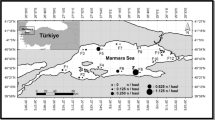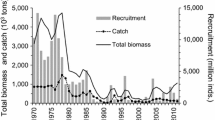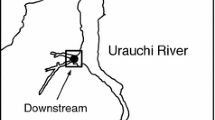Abstract
Kuhlia sandvicensis, the aholehole, is a native Hawaiian fish found in both marine and freshwater habitats. In the lower reaches of streams, they are predators on stream fishes, invertebrates, and insects. Aholehole are an important food fish in the Hawaiian Islands and were often used by ancient Hawaiians in traditional ceremonies. Although aholehole are an important part of stream ecosystems and Hawaiian culture, little is known about their life history, specifically, whether a freshwater phase is obligatory. In this study, light microscopy and electron microprobe techniques were used to analyze otolith daily increments. The analysis estimated age of juveniles and provided information regarding salinity of a fish's habitat at specific points in its life. Sr/Ca profiles from otoliths of juvenile and adult fish from fresh and salt water indicated that this species' use of stream habitats is facultative. Unlike Hawaiian freshwater gobies and at least one other member of the Kuhliidae from the Western Pacific, there is no physiological requirement of fresh water at a specific point in the life cycle of K. sandvicensis. Future research will provide a greater understanding as to the importance of streams as nursery habitats for this species. The research is expected to bolster the argument for maintaining the stream-ocean corridor for access by amphidromous gobies and perhaps also for the aholehole.
Similar content being viewed by others
References cited
Broecker, W.S. 1974. Chemical oceanography. Harcourt Brace Jovanovich, New York. 214 pp.
Brothers, E.B. 1978. Exogenous factors and formation of daily and subdaily growth increments in fish otoliths. Amer. Zool. 18: 631.
Brothers, E.B. & W.N. McFarland. 1981. Correlations between otolith microstructure, growth and life history transitions in newly recruited French grunts (Haemulon flavolineatum (Desmarest, Haemulidae). Rapp. P.-v. Reun. Cons. Int. Explor. Mer 178: 369–374.
Campana, S. & J.D. Neilson. 1982. Daily growth increments in otoliths of starry flounder (Platichthys stellatus) and the influence of some environmental variables in their production. Can. J. Fish. Aquat. Sci. 39: 937–942.
Fitzsimons, J.M., R.T. Nishimoto & W.S. Devick. 1996. Maintaining biodiversity in freshwater ecosystems on oceanic islands of the tropical Pacific. Chinese Biodiversity 4(Suppl.): 23–27.
Gosline, W.A. & V.E. Brock. 1965. Handbook of Hawaiian fishes, 2nd ed. University of Hawaii Press, Honolulu. 372 pp.
Kalish, J.M. 1990. Use of otolith microchemistry to distinguish the progeny of sympatric anadromous and non-anadromous salmonids. U.S. Fish. Bull. 88: 657–666.
Morales-Nin, B. 1992. Determination of growth in bony fishes from otolith microstructure. FAO Fish. Tech. Paper 322. 51 pp.
Pannella, G. 1971. Fish otoliths: daily growth layers and periodic patterns. Science 173: 1124–1127.
Pannella, G. 1974. Otolith growth patterns: an aid in age determination in temperate and tropical fishes. pp. 28–39. In: T.B. Begenal (ed.) The Ageing of Fish, Unwin Brothers, London.
Radtke, R.L. 1989. Strontium-calcium concentration ratios in fish otoliths as environmental indicators. Comp. Biochem. Physiol. 92A: 189–193.
Radtke, R.L. & R.A. Kinzie. 1996. Evidence of a marine larval stage in endemic Hawaiian stream gobies from isolated highelevation locations. Trans. Amer. Fish. Soc. 125: 613–621.
Radtke, R.L., R.A. Kinzie & S.D. Folsom. 1988. Age at recruitment of Hawaiian freshwater gobies. Env. Biol. Fish. 23: 205–213.
Ralston, S. & G.T. Miyamoto. 1983. Analyzing the width of daily otolith increments to age the Hawaiian snapper, Pristipomoides filamentosus. U.S. Fish. Bull. 81: 523–535.
Rieman, B.E., D.L. Myers & R.L. Nielsen. 1994. Use of otolith microchemistry to discriminate Oncorhynchus nerka of resident and anadromous origin. Can. J. Fish. Aquat. Sci. 51: 68–77.
Secor, D.H., A. Henderson-Arzapalo & P.M. Piccoli. 1995. Can otolith microchemistry chart patterns of migration and habitat utilization in anadromous fishes? J. Exp. Mar. Biol. Ecol. 192: 15–33.
Taubert, B.D. & D.W. Coble. 1977. Daily increments in otoliths of three species of Lepomis and Tilapia mossambica. J. Fish. Res. Board Can. 34: 332–340.
Tsukamoto, K., I. Nakai & W.V. Tesch. 1998. Do all freshwater eels migrate? Nature 396: 635–636.
Author information
Authors and Affiliations
Rights and permissions
About this article
Cite this article
Benson, L.K., Michael Fitzsimons, J. Life History of the Hawaiian Fish Kuhlia sandvicensis as Inferred from Daily Growth Rings of Otoliths. Environmental Biology of Fishes 65, 131–137 (2002). https://doi.org/10.1023/A:1020045525086
Issue Date:
DOI: https://doi.org/10.1023/A:1020045525086




